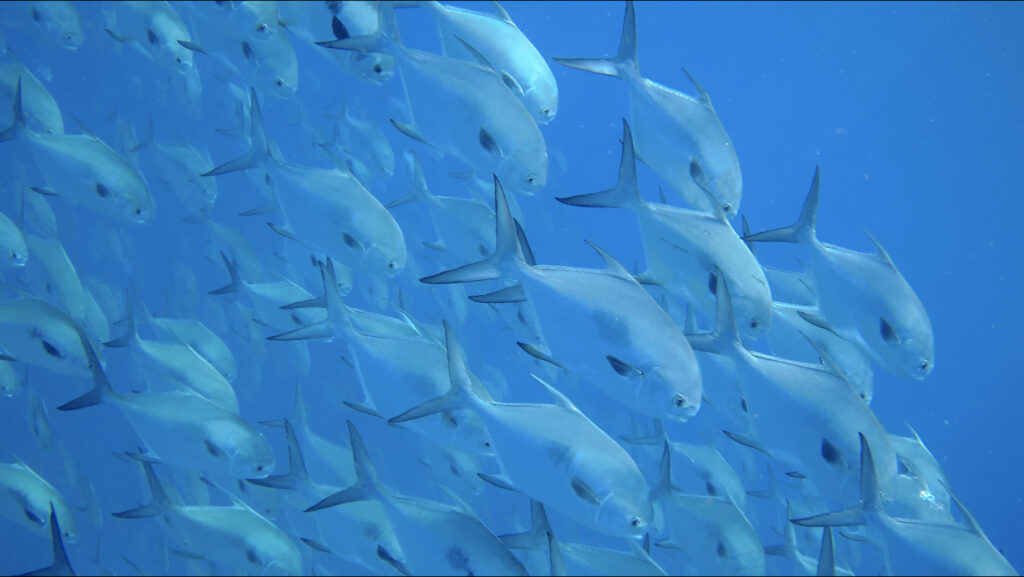A school of permit at Western Dry Rocks. Photo: Dr. Ben Binder
Catching a permit on fly in the Florida Keys is widely regarded as one of the most difficult challenges in the sport. Unfortunately, the Keys permit face many stresses, including aggregation overfishing, habitat loss on the flats and reef, water quality declines, increasing vessel traffic, and stresses connected to climate change. BTT has worked collaboratively with the Lower Keys Guides Association (LKGA) to find science-based solutions that will ensure the Florida Keys’ iconic permit fishery will thrive now and into the future.
Results from the first year of a new permit monitoring project at Western Dry Rocks are summarized below and represent the latest work under Project Permit, sponsored by Costa Sunglasses and LKGA. Previously, BTT worked with the Florida Fish and Wildlife Conservation Commission (FWC) in 2011 to enact a special permit zone that expanded harvest restrictions for Florida Keys permit. Most recently, and guided by BTT’s subsequent research, FWC implemented a seasonal no-fishing closure at one of the most important spawning aggregations for permit in the Lower Keys, Western Dry Rocks. The benefits of protecting Western Dry Rocks should be realized in the next 5-10 years.
The WDR closure is currently provisional and will sunset at the end of seven years if there isn’t sufficient scientific evidence demonstrating its benefit. That’s where BTT steps in again. In order to provide the data necessary for FWC to make informed decisions about management, BTT has funded two studies to track the recovery of the WDR aggregation and research aggregations at three other sites that remain open to fishing during spawning season.
In the first study, which is being conducted by collaborating scientists at Carleton University, BTT is tracking permit to compare their movements before vs after the spawning season closure at WDR. The study seeks to answer a number of important questions: Do permit spend more time at Western Dry Rocks during spawning season now compared to prior to the closure? Are permit more likely to visit the closed area year after year than they did prior to the closure? Are permit less likely to visit other aggregation sites that are open to fishing and remain at WDR?
The receivers to detect permit movements in this study are all placed at spawning sites and along the reef, because the study is specifically examining when permit move to the reef, how many go there, how long they stay, and whether these patterns differ from the pre-closure period. Research teams tagged 60 permit across three aggregation sites in 2022 and results from last year’s spawning season have just been analyzed. Given that the closure has only been in place for one year, we didn’t expect any major changes to be exhibited yet.
Key findings from the first-year tracking research include:
- Permit spawning behaviors have not changed appreciably between pre-closure and one year after the closure.
- Spawning permit arrived in March, their presence peaked in April, and decreased in July.
- A majority of permit that spawned at WDR left WDR after spawning and were not detected at other locations on the reef tract after July.
In the second study, which is being conducted by our collaborating scientists at Florida International University, BTT is funding the use of sophisticated sonar to count the number of spawning fish, estimate their body size, and count the number of sharks surrounding the aggregations at WDR and three other aggregation sites. Similar to the tracking study, we don’t expect measurable changes in the first year but rather in subsequent years.
Key findings from the first year of surveys are:
- The number of spawning permit at WDR is approximately double the number of spawning fish at the other sites.
- The number of sharks around the permit aggregation at WDR is much greater than the number of sharks around the aggregations at the other sites.
- The number and body size of spawning fish at all sites has not changed following the closure.
- Similar to the tracking research, the abundance of permit at the studied aggregation sites peaked in April and ends in June/July.
BTT is fully committed to the conservation of permit in the Lower Keys and will continue to work with our partners at LKGA to explore science-based solutions to ensure that fishery has a sustainable future.




